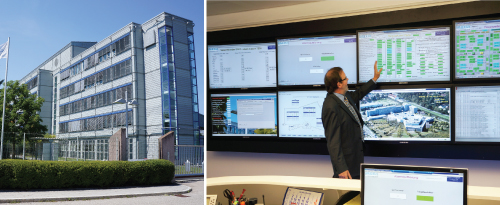Gracia Chiang gets a behind-the-scenes peek at the Amadeus Data Centre in Germany, which powers over a billion transactions a day

The Amadeus Data Centre in Erding; infrastructure manager, Matthias Koll, explaining how every corner of the facility is closely monitored
Dubbed the ‘brain behind travel’, the Pentagon-like global data processing centre in Erding offers an interesting insight into what happens when a travel consultant in Bangkok, Sydney or anywhere else in the world attempts to make a booking for his client through the Amadeus platform.
Stepping into the 24-year-old facility, which sits close to the Munich airport, one is immediately struck by how security and safety are the cornerstones of the highly resilient structure. For instance, its exterior walls and roof are made of 1m-thick steel reinforced concrete with no windows, its external doors are 50cm-thick solid steel, and there is round-the-clock staffed security, with video cameras both inside and outside the premises.
“There is redundancy in all critical areas and no single point of failure”, said Eberhard Haag, executive vice president, global operations, Amadeus, explaining that a back-up component will kick in when one temporarily fails.
We are told that Erding is an area with no risk of floods, tornadoes, hurricanes or similar calamities. However, Haag revealed that there was a disaster centre sited nearby, where quarterly rehearsals are conducted as part of contingency plans.
The lengths taken to ensure continued service delivery is not surprising considering that the centre handles as many as 17,000 transactions per second at its peak, out of which around 2,000 are from Asia-Pacific. Among the technology provider’s clients are over 700 airlines, 110,000 hotel properties and 207 tour operators spanning more than 195 countries. It is not just travel bookings that are processed here; the data centre also delivers mission-critical services such as departure control and flight management for airlines who use Amadeus’ IT systems.
Our group of eight was ushered into one of six server rooms, where we were shown how efforts were taken to ensure optimal temperatures all day long, by use of room configurations that faciliate hot/cold air flows and cooling floor vents.
The building is separated into three individual data centres with three independent technical zones, served by nine diesel power generators in four locations and four uninterrupted power supply systems. To support growth in its IT solutions business, Amadeus also recently announced the opening of a new ‘energy annexe’, roughly doubling the data centre’s overall power and cooling capability.
When asked if there have been occasions when the centre has been stressed, Haag admitted that the “storm of transactions” that occur when airlines run promotions is “highly dangerous”, but he said that there was enough buffer for every airline. “If the promotions are not coming at the same moment, we can easily cover six times more traffic than usual.”
Said Haag: “We are extremely scalable…year by year our capacity growth is 30 per cent. It’s not just coming from pure bookings, it’s coming from transactions: the number of customer inputs and requests are driving our capacity load.”
This is due in part to how Amadeus’ role has evolved. In the past, when its services were mainly delivered to traditional travel agencies, there would be around five transactions before one booking; now that Amadeus is also rolling out its products to websites, there can be some 2,500 transactions to one booking, noted Haag.
As for his 2020 prediction, Haag said he saw Amadeus having multiple data centres – one in Europe, one in Asia-Pacific and one in North America – to mitigate risks. This may not be far off, considering that there are already teams sitting outside of Europe who manage the data centre remotely during their respective time zones in a follow-the-sun concept. A typical operations day starts in Erding, and by 16.00, handovers to colleagues in Miami are carried out, who work until day breaks in Sydney, where the final shift kicks in.
Data processing is hardly sexy, but this was honestly a fun excursion into the heart of travel IT. Plus, visiting the hometown of one of German’s best breweries had its perks. Erdinger for lunch, anyone?




















